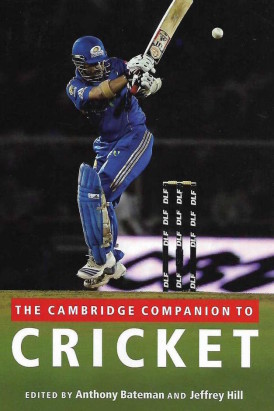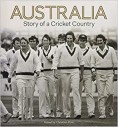The Cambridge Companion to Cricket
Jon Gemmell |Published: 2011
Pages: 308
Author: Bateman, Anthony and Hill, Jeffrey (editors)
Publisher: Cambridge University Press
Rating: 4 stars

The association of Cambridge with cricket stimulates the imagination to the start of season friendlies, picturesque grounds and a few hardy souls wrapped in blankets clutching a thermos.
The Oxbridge universities now have to share their lofty position with four other academic institutions in the pursuit of both academic and cricketing excellence.
It is doubtful that any of them will be responsible for a work as notable as “The Cambridge Companion to Cricket” released to coincide with either the start of the County Championship or (more likely) the climax of the World Cup.
Seventeen chapters are condensed into 270 pages, written according to former Indian captain Ravi Shastri by the “best intellects working on the subject.”
Between them they provide insights into the sport’s history, examine the impact of significant individuals and cast a critical eye on future development.
Impressively, the collection regularly delves into the sport’s copious and diverse literature. In the introduction the editors Anthony Bateman and Jeffrey Hill marvel that cricket writing appears “to transcend mere sports reporting.”
So we see HG Wells’s “The War of the Worlds” in which a character suggests that through playing cricket “we shall save the race” and JM Barrie who argued that the “great glory of cricket” is to be found not on the international stage but on the “village greens, the cradle of cricket.”
These ideals of cricket would, we assume, be played by men. Cricket was used to promote the ideals of manliness and Patrick McDevitt views the bodyline series between England and Australia in 1932/33 in terms of “being a man.”
Whilst The Times would describe the third Test at Adelaide as “the most disagreeable match that has been played since the game began”, the English countered Australian questioning the spirit of the game by in turn questioning their masculinity.
For English captain Douglas Jardine, “may the best man win” became not a greeting to his opponent but something that needed to be confirmed by an English victory.
World Series Cricket provides another landmark, one that first witnessed the exploitation of the sport for television. Media magnate Kerry Packer sought to fill his television stations with sport, and the when the Australian Cricket Board declined his offer he by-passed national boards and hired the best in the game at lucrative fees.
Richard Cashman looks at how interpretations of Packer’s impact on cricket have changed over the years. Once cited as a “selfish corporate raider who had little interest in the culture and traditions of cricket” he has been reassessed in terms of commercial impact, for challenging outmoded visions of the game’s social position and for delivering a new audience to cricket. At the outset of WSC he was considered an adversary, yet his death on December 26, 2005 was marked by a minute’s silence at the MCG and the wearing of black armbands.
A history of the Newlands cricket ground shows that South Africa’s exclusion from international cricket was not just a consequence of apartheid legislation but was rooted in colonial policy.
Resistance to racism runs through any study of cricket in the Caribbean. Fast-bowler William Burton’s tour to England in 1906 ended abruptly when he was sent home for refusing to carry out menial duties for white members of the side.
The great West Indian sides of the 1980s and 90s were a consequence of a wider struggle for social justice and political freedom at home and came to embody dignity and honour for migrants in England.
Three essays look at cricket in today’s powerhouse India. As well as being 50-overs world champions, India are also the number one ranked Test-playing side, providing them with a dominance only previously enjoyed by Australia and the West Indies.
Sachin Tendulkar has provided the platform on which this supremacy has been constructed.
He is not just a prodigious cricketer but a figure who has assumed icon status. The cult of Tendulkar is a creature created and shaped by the development of India’s media.
By the end of the twentieth century a growing literature that encompassed newspapers, magazines and books were devoted to cricket. Television was starting to expand towards the end of the 1980s as Tendulkar’s career was beginning.
Television coverage coincided with the explosion of one-day cricket.
Economic liberalisation opened the floodgates to foreign firms looking to India as a market through which to expand sales and cricket became a means through which the whole of the nation’s middle class could be reached.
Tendulkar came to symbolise the “cultural self-assertion of the rapidly expanding Indian middle classes.”
For Boria Majumdar the IPL has concluded Indian cricket’s decolonisation and completed the shift of the sport’s nerve centre to the subcontinent.
One of the reasons that cricket’s literature is elevated over that of other sports is that writers have invested an essence or ethos into the sport and become animated when its soul is threatened by commercial interests for “something more than just a game appears to be at stake.”
Cricket in India has become more than a sport, being akin instead to entertainment.
When you need “noodle straps, tarot cards and models amidst the fans” to keep coverage viewer-friendly, you have to worry for the sport’s longevity. To claim that Test cricket is “considered by a minuscule minority of fans across the world as the real test of a player’s ability” then you fear its very existence.
Brian Lara is revoked as an entertainer rather than a successful leader who could have prolonged the “dream of regional nationalism held by earlier generations.” Hilary Beckles charts the decline of the team through its leaders.
Frank Worrell was the Founding Father, Gary Sobers the King, Clive Lloyd a Statesman, Vivian Richards a General and Brian Lara a Prince. This leaves Chris Gayle, “undoubtedly the Don of the posse – unchallenged leader of the ‘gang.'”
Insights such as these ensure that whilst cricket faces an uncertain time, its writers and historians shall preserve something that is very special and provide a vessel through which the impact of wider social changes can be measured.
The Cambridge Companion to Cricket undoubtedly contributes to this social heritage. It is written mainly by academics but is devoid of language that leaves you reaching for the dictionary and is priced so that it can be read outside of the University library.
My only complaint stems from (my own) greed.
It is always difficult when assembling a team who to leave out, but the absence of chapters on female cricket, Zimbabwe and Pakistan leaves one hoping that a second volume is being conjured up, preferably to coincide with the start of another (4-day County Championship) season.






Leave a comment